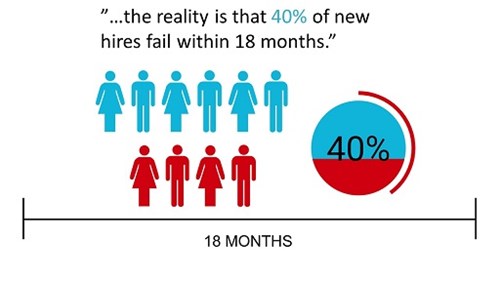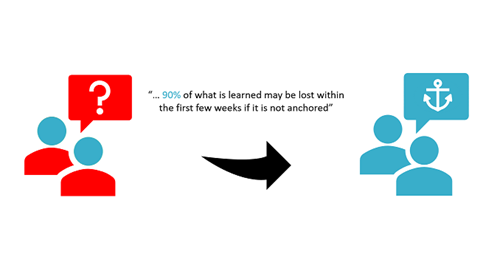Selecting the right people for high performance organizations!
"One of the most important values in business is to value people, because every organisation and company is only the sum of talented and skilled individuals." - Norbert Mörtl, Master International A/S
- Albert Einstein
One of the most important values in business is to value people, because every organization and company is only the sum of their talented and skilled individuals.
From my experience of working with high performance organizations over the past 25 years, companies need to have the right person for the right job in order to achieve continuous organizational growth and success. Retaining them and continuously developing and motivating them is paramount for a company’s long term success.
This means that organizations need to understand that their most valuable assets are their employees, especially since more and more companies are becoming knowledge-intensive. Attracting and hiring high-achievers whose abilities and behavior match the job criteria is critical if companies are to be successful.
Retaining these employees decreases uncertainty and helps to cut costs. Nevertheless, the reality is that 40% of new hires fail within 18 months! (Source: http://www.forbes.com/sites/danschawbel/2012/01/23/89-of-new-hires-fail-because-of-their-attitude/)


How do you hire, retain and motivate the people best suited for your company?
Master International has helped successful companies to select and retain the best candidates for the right jobs by identifying and developing potential. We begin by first identifying crucial behavior traits and abilities for success in any given job. Being able to do so requires a thorough knowledge of what you are looking for - if you don’t know what you are looking for, you won’t know when you have found it!
You need to be able to clearly establish success criteria for each position in the form of key personality traits and abilities such as logical and analytical reasoning and motivation. (Criteria can be established using personality and cognitive tests like MPA and ACE from Master)
One way of doing this is to use BIG DATA. The reality however, is that many companies do not have the time, the resources, the expertise or the data available, or perhaps these processes are not yet part of their daily business activities. This notion is clearly backed up by research carried out by Bersin/Deloite, which revealed that only 4% of companies have achieved the capability to perform “predictive analytics” about their workforce. (Understanding the drivers of performance and retention, using statistics to decide who to hire, analyzing how pay correlates to performance, etc.) In fact, only 14% have done any significant “statistical analysis” of employee data at all.
A successful alternative: SMART data
Smart data is a more pragmatic approach allowing for a smarter use of existing HR data, by eliminating silos of information, which companies have created through the use of independent recruitment and development departments within their human resource (HR) systems or through outsourcing of testing and recruitment.
Modern HR Assessment Platforms (like Metis from Master), enable companies to use existing HR data intelligently and in a SMART way. It combines all test and assessment data on one platform, from screening (for example using Bright) to selection and development (using Master Person Analysis or ACE), to collecting of relevant data and finally connecting the silos of information through integration and analysis.
Data from your best performers can then be used to create a predictive success profile (Criteria) with the needed, proven characteristics for each job role. This data can be used in a SMART way to help in the selection of future employees or candidates for talent development.

Knowing what you’re looking for will help you to match and identify the right candidate for the right job. Matching employee potential and job complexity will help you conduct quality interviews with relevant potential employees, thus saving time and money.
For example, a financial services organization analyzed high performers in its sales organization and then used those factors (called "dimensions") to screen candidates, raising first-year sales performance by more than 20 percent. (Bersin/Deloite)
These insights enable better and smarter HR decision making, increase profitability, reduce uncertainty and improve HR processes, creating better performing companies, based on selection of people best suited for the job, who will stay motivated and engaged.
How can you conduct and manage T&D in a way that increases effectiveness?
For T&D to be effective it needs to be aligned with the company’s strategy, as Josh Bersin (2014) said, “Today’s corporate training organizations must be highly aligned with their business’ immediate and urgent corporate priorities, while also building long term capabilities for the future”.
According to Silverman R.E (2012): The first step in doing training is to do a training-needs analysis, figuring out who needs training and what kind”. Some of the advanced development tests like EASI can be useful in this part of the process.
Secondly a conducive environment and a learning culture need to be created in the company: 90% of what is learned may be lost within the first few weeks if it is not anchored, reinforced and transferred to the workplace.

Companies must give employees the opportunity, freedom and support (from managers) to practice and apply the skills and knowledge they have acquired in T&D and the motivation to sustain, if learning is to be effective.
This is strongly supported by a study of 3 HR and 4 Operational Management (OM) practices in a longitudinal study. The results showed that none of the OM practices had any significant effect on productivity. Out of the 3 HR practices, empowerment (7%) and training (6%) added an aggregated 9% value per employee (Birdi, K et al., 2008, P.490)
Companies need highly skilled workers as a strategic differentiator, especially when competing on quality (Wilkinson & Redman, 2013, p.161). Recent studies within companies show that 7 out of 10 employees are not reaching their full potential because of lack of T&D.
Investing in T&D helps companies to stay competitive and makes it a great place to work. It motivates employees to develop, feel committed, stay loyal and allows them to use their competence and experience for the company on a long-term basis.
High-impact learning organizations are aware that they need to be rapid and flexible in their T&D activities to match and respond to the quickly changing business conditions and the resulting needs from a company’s strategy.
Companies, which provide an environment that fosters learning, empower and motivate their employees to transfer acquired knowledge to the workplace, while retaining them and their experience/know-how, are sure to have a ROI of their T&D (not costs) investments!
A humorous quote to summarize the dilemma of T&D:
CFO to CEO: What happens if we train all our employees and they leave us?
CEO to CFO: What happens if we don’t and they stay?
How can you retain your employees and keep them motivated for high performance?
It is a fact that companies with engaged and motivated employees are 20% more productive and profitable than their competitors.


For companies to increase their performance (and profit), it is crucial to keep their employees motivated while keeping their know-how in the company.
To find out what motivates, we have to understand what the real reasons are underlying the expressed behaviour, then we can make conscientious decision through which “goal –directed behaviour is initiated, energized, directed and maintained” (Buchanan and Huczynski 2010, p. 267)
Can leaders increase performance through motivation?
Leaders must realize that they cannot “force motivation” (Frick D. 2011) and understand that intrinsic factors (persons needs and motives) play a major role in motivation and support it by influencing extrinsic factors (job enrichment, being fair and creating valid expectations)
Peter Drucker defined knowledge workers as “employees that work with information and who develop and use knowledge in the workplace”, as “associates than subordinates” who want to be involved in making judgements and decisions (Drucker, 1973, 1999)
His study showed that the main positive motivating factors clearly were intrinsic and emotion based like relationships, meaning and values, the possibility to advance, learn and empowerment, while Money and compensation had lower priorities. The negative factors that can hinder motivation proved to be mainly external, out of the control of the employee, like bad managers, lack of support, resources, technology and planning.
This certainly has a high correlation with Herzberg’s finding Source: Herzberg, 1968 (Study, 685 employees) about Hygiene versus motivating factors. Hygiene factors (work conditions, salary and supervision) are extrinsic and can hinder job satisfaction while otherwise not contributing to increased performance.
The motivator factors are intrinsic from the inner will (achievement, recognition, growth and responsibility) and have a long term effect to create real increased job performance.
An experiment with the goal to create increased performance introduced one group (Achieving group) to motivator factors like responsibility, growth and recognition compared to the Control group which kept a status quo. The achieving group showed, after a short dip, a clear increase of performance while developing a more positive work attitude resulting in lower absenteeism. Source: Herzberg, 1968
Herzberg also shows that compensation or the promise of reward have only a short term effect and are no long-term trigger of motivation. It has also been called seduction and rape. (Herzberg, 1968)
Long-term motivation through multifaceted approach
The focus on motivation must be on a broad basis rather than single factors. In 2 major studies (385 and 300 employees) it was proven that performance will increase when several drivers or emotions are satisfied and triggered.
Nohria N. and Groysberg B. (2008) created the 4 Drive model based on newer findings in neuroscience, which identifies 4 drives that underlie motivation and can be levered by leaders: Acquire (Reward system), Bond (Culture), Comprehend (Job design) and Defend (Performance and resource management).

The result from the study show that activating one drive has very little effect, while if all 4 are satisfied an amazing 38 percentile increase in motivation can be achieved. Source: Nohria N. & Groysberg B. (2008). It points out that for employees to stay motivated, they “expect their direct managers to do their best to address all four (drivers) within the constraints that the institution imposes”.
The above findings show that “leaders can mould an environment that allows workers to motivate themselves”, but to avoid placing too much emphasis on the typical “attempts to extrinsically motivate workers (which) are often counterproductive” (Frick D. 2011, p. 383). That doesn’t mean that pay-increase and rewards are not needed, they must be adequate and fair.
The effort should be on removing any barriers to performance, like de-motivators that create dissatisfaction. “It would be better to use the time and resources to eliminate all the negative aspects that could hinder performance, like bad management, lack of resources” etc. (Sprenger, 2007)
Leaders must adopt Mc Gregors “Theory Y” assertion and really believe that “employees will seek out and accept responsibility, exercise self-control and self-direction, and will work well given the right conditions” (Frick D. 2011, p. 383), giving them accordingly the freedom and framework to thrive in.
Leaders should create an open, fair and embracing culture while setting clear, specific and challenging goals that enhance growth and get rewarded, taking into account individuality.
Concluding with Collin’s advice:
“You cannot manufacture passion or ‘motivate’ people to feel passionate. You can only discover what ignites your passion and the passion of those around you” Collins (2001).







